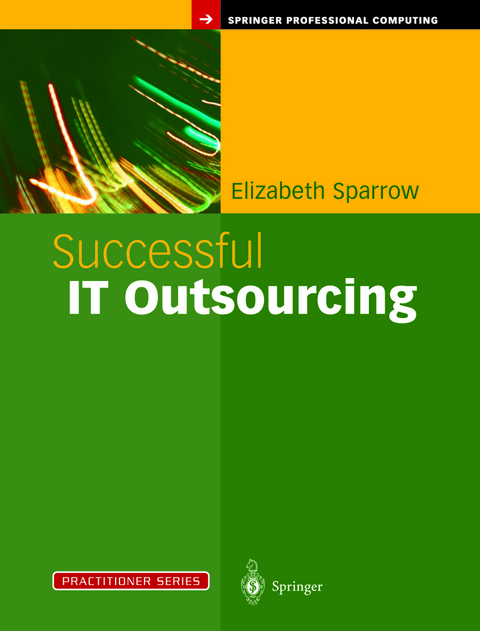
Successful IT Outsourcing
Springer London Ltd (Verlag)
978-1-4471-1114-6 (ISBN)
Successful IT Outsourcing considers:
- The objectives behind outsourcing
- The selection of a service provider
- The management and measurement of the performance of outsourced services
- The role of the outsourcing contract
- Why outsourcing sometimes fails and how to turn failure into success
Features and Benefits:
- Describes the origins of IT outsourcing, and recent developments
- Examines the way in which an organization might determine whether to outsource and how it can choose a service provider
- Discusses how to develop effective outsourcing relationships
- Provides context and advice to assist IS professionals, whose work is being outsourced, as they consider their future careers and the possibility of transferring to a new employer
1. Introduction to IT Outsourcing.- 1.1 What Is IT Outsourcing?.- 1.2 History of IT Outsourcing.- 1.3 Size and Scope of the IT Outsourcing Market.- 1.4 Different Sourcing Models.- 2. The Case For and Against Outsourcing.- 2.1 Introduction.- 2.2 Arguments in Favour of Outsourcing.- 2.3 Arguments Against Outsourcing.- 2.4 If Your Department Is to Be Outsourced.- 3. Objectives and Parameters for Outsourced Services.- 3.1 Introduction.- 3.2 The Importance of Objectives.- 3.3 Understanding Stakeholders’ Objectives.- 3.4 Analysing Objectives.- 3.5 Selecting Outsourcing Candidates.- 3.6 Benchmarking.- 3.7 In-house Improvements.- 3.8 Defining Service Requirements.- 3.9 Business Case Analysis.- 3.10 StaffTransfers.- 3.11 Outsourcing Programme Management.- 4. Choosing a Service Provider.- 4.1 Introduction.- 4.2 Managing the Selection Process.- 4.3 Investigating the Computer Services Market.- 4.4 Evaluation.- 4.5 Short-listing Potential Suppliers.- 4.6 Selecting the Preferred Bidder.- 4.7 Negotiations.- 4.8 Contract Award.- 4.9 The Importance of the Relationship Between Customer and Supplier.- 5. Managing Performance.- 5.1 Introduction.- 5.2 Building Outsourcing Relationships.- 5.3 Understanding Stakeholder Perspectives.- 5.4 Outsourcing “Partnerships”.- 5.5 Communicate, Communicate, Communicate.- 5.6 Transition.- 5.7 Incentives and Disincentives.- 5.8 Adding Value.- 5.9 Contract Management.- 5.10 Service Management.- 5.11 Service Users.- 5.12 Contract Administration.- 5.13 Outsourcing Management Organization.- 5.14 Meetings.- 5.15 Change Control.- 5.16 Issue Management and Problem Escalation.- 5.17 Critical Success Factors.- 6. Measuring Performance.- 6.1 Introduction.- 6.2 Linking Performance Measures to Objectives.- 6.3 Setting a Baseline.- 6.4 Benchmarking.- 6.5Measuring Benefits.- 6.6 Involving Service Users.- 6.7 Service Level Management.- 6.8 Service Level Agreements.- 6.9 Managing Multiple Suppliers.- 7. Risks and Controls.- 7.1 Introduction.- 7.2 Outsourcing Contracts.- 7.3 Outsourcing Risks.- 8. When Outsourcing Fails to Deliver.- 8.1 Introduction.- 8.2 Reasons Why Outsourcing Fails.- 8.3 Warning Signals.- 8.4 Challenging Failure.- 8.5 Formal Action Against Your Supplier.- 8.6 Backsourcing.- 9. ASPs, WASPs and the Future of Outsourcing.- 9.1 Alternative Supply Models.- 9.2 Other Outsourcing Trends.- 9.3 The Impact of Outsourcing on the IT Department.- 9.4 Conclusion.- Useful Websites.
| Reihe/Serie | Practitioner Series |
|---|---|
| Zusatzinfo | XV, 272 p. |
| Verlagsort | England |
| Sprache | englisch |
| Maße | 178 x 254 mm |
| Themenwelt | Informatik ► Office Programme ► Outlook |
| Informatik ► Software Entwicklung ► User Interfaces (HCI) | |
| Mathematik / Informatik ► Informatik ► Theorie / Studium | |
| Mathematik / Informatik ► Mathematik ► Finanz- / Wirtschaftsmathematik | |
| Wirtschaft ► Betriebswirtschaft / Management ► Logistik / Produktion | |
| ISBN-10 | 1-4471-1114-1 / 1447111141 |
| ISBN-13 | 978-1-4471-1114-6 / 9781447111146 |
| Zustand | Neuware |
| Informationen gemäß Produktsicherheitsverordnung (GPSR) | |
| Haben Sie eine Frage zum Produkt? |
aus dem Bereich


